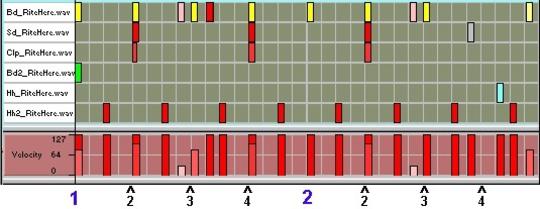Let’s get the dance floor moving with compelling beats
Let’s start with the most important tip of all:
ALWAYS PROGRAM YOUR BEATS WHILE OTHER INSTRUMENTS ARE PLAYING!
You don’t need much: a bassline, a percussive synth part, and maybe a pad. Playing along with other instruments keeps your beats from getting off on some mutant tangent, and lets them play well with others.
The bass part is especially important. Program the bass first, and if it’s a line that makes you want to move, the drums will fall together perfectly. And when creating beats, be honest with yourself. If you don’t start moving around like a gerbil in heat when your drum loop plays back, the people on the dance floor won’t either. Don’t waste time fixing something that doesn’t work: start over from scratch, and remember you’re there to have fun.
PLOP-FLOAT-TEASE
Most loops are either one, two, or four measures. Each kind has a different personality, so get to know your beats, and use them for what they do best.
One measure: Aside from daytime television, there are few things more boring than a one-measure loop repeated by itself over and over and over again. So, a one-measure loop’s mission in life is to provide a background for other beats, percussion parts, or goofy sounds, so you can put together layers that work together. The best one-measure loops are plain and normal. Clever syncopations, if played over and over, are like a house guest who just won’t leave. For one-measure beats, simple = good.
Two measures: Two-measure loops are cool because they’re like aerobics – one measure breathes in, the next breathes out. The structure I use for two-measure beats is “plop-float-tease.”
Plop means a heavy downbeat. Make the velocity on the kick drum a little higher, increase the kick treble a bit so it hits harder, layer a low tom hit with the kick…anything that makes the sound plop. You want people to feel, not just hear, the downbeat.
Float is the middle section. This is more like the one-measure concept, you want something that’s fairly neutral and keeps the beat progressing, without calling a lot of attention to itself.
Tease disrupts that normal flow and sets you up for the next plop. This can be some tom hits, removing the kick and hats for a couple of beats while you slip in something else, a breakbeat, whatever. If you apply beatus interruptus, when the beginning of the loop hits again, you have a strong downbeat that “re-syncs” the dancer’s butts/brains.
Check out the screen shot and listen to the audio example.

The big 1 and 2 are measure starts. The little numbers are beats within the measures. (By the way, Reason doesn’t look like this; I’ve colorized it to show up certain beats.)
The green note at the beginning is an extra, deep-sounding kick to give that satisfying downbeat “plop.” The middle pretty much floats, with kicks occurring on every beat (shown in yellow), although there are also a few semi-tease accents just to keep things interesting around measure 1, beat 3 and measure 2, beat 3.
The “tease” part starts just before measure 2, beat 4. The gray snare hit comes just before the beat—a big element of surprise. The kick that would normally occur at measure 2, beat 4 isn’t there; instead, it’s been shifted to the last beat to lead into the downbeat better. Finally, an extra hi-hat hit (blue) adds even more interest.
USE SWING TO ADD A HUMAN FEEL
Swing lengthens the first note of an equal-valued pair of notes, and shortens the second one to compensate. Especially for hip-hop type tempos that are 100 BPM or less, injecting swing is like taking Vitamin Beat. Even a little, like 55%, will make a difference.
LOSE THE CYMBALS
Cymbals are musical one-night stands: you want them to show up, party, and leave. So make loops without cymbals, then add one-shot (single event, non-looped) cymbals on a separate track.
PERCUSSION TIPS
Don’t get fancy with the kick, snare, and hats. You need a rock-solid foundation so dancers can feel the groove. But you also need some ear candy on the top, which is percussion’s job description. But behave yourself: keep the levels sane (you want them to complement, not dominate), and use velocity a lot to vary dynamics.
THE PHYSICS OF DANCE MUSIC
Albert Einstein once said that E = MC2, which means if you get enough mass moving fast enough, it becomes energy. That’s the whole point of beats. Get those butts moving, and you’ll create a lot of energy. More energy = more dancing = more sweating = more people going to the bar for drinks = more money for the club owner = job security for you.